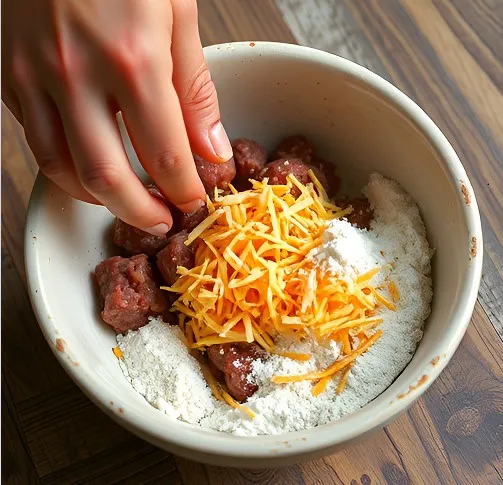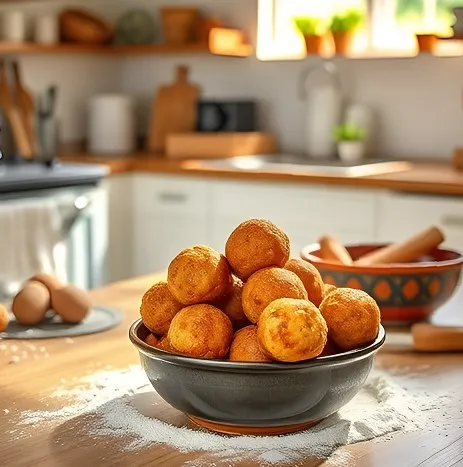There’s something undeniably satisfying about a warm, savory bite of a quality sausage ball. Whether you grew up with homemade treats or experimented with store-bought mixes during a busy weeknight, there’s no denying that Bisquick has long been the go-to option for many home cooks. Yet, as the culinary landscape evolves and our tastes demand more authenticity, flavor, and control over ingredients, more and more home chefs—and even professional food bloggers—are turning to homemade alternatives to elevate this classic snack.
Table of Contents
PRethinking Convenience—Why Ditch Bisquick?
The Convenient but Flawed Legacy of Bisquick
Let’s be honest: Bisquick was designed for ease. It’s a fast, reliable fix when you’re short on time or energy. However, convenience often comes at a cost. While you might appreciate the simplicity of opening a box and letting it lead your recipe, that same processed mix sometimes falls short when it comes to genuine flavor and texture. Many who use Bisquick find that their sausage balls, while undeniably quick to make, suffer from a slightly bland taste or a texture that feels a bit “off.” This is partly due to the additives and processing methods used to ensure a long shelf-life, but also due to the one-size-fits-all nature of a pre-made mix.
The Case for Homemade
By making sausage balls completely from scratch, you reclaim control over every aspect of your dish. Imagine selecting your favorite high-quality sausage, choosing the perfect blend of cheeses, and tweaking the spices to match your personal taste—all while knowing exactly what ingredients are going into your recipe. For many, this act of cooking becomes a genuine labor of love that not only results in a tastier snack but also enriches the cooking experience. Making these savory morsels from scratch isn’t just about avoiding processed mixes—it’s about celebrating the art of cooking and ensuring every bite bursts with flavor.
The Essential Ingredients for Perfect Sausage Balls
Choosing the Right Sausage
At the heart of every outstanding sausage ball is, undeniably, the sausage itself. The quality and type of sausage you select can dramatically influence the overall flavor profile. For a robust, savory bite, many home cooks prefer a high-quality pork sausage because its ideal balance of fat and meat yields a moist and flavorful result. However, if pork isn’t your cup of tea—or if you’re aiming for a leaner alternative—turkey sausage or even a spicy Italian sausage can offer splendid results. The key is to choose a sausage that isn’t overly lean; a measure of fat is essential not only for flavor but also to ensure a juicy texture after baking.
The Role of Flour in Binding
Without Bisquick to do the heavy lifting, flour naturally takes center stage as the binder in your homemade version. While all-purpose flour typically serves as the most reliable choice, providing that perfect balance of density and tenderness, some adventurous cooks experiment with lighter options such as cake flour, aiming for a slightly more delicate texture. However, for consistency and a dependable outcome, sticking with all-purpose flour is often the best approach when it comes to achieving a balanced bite every time.
Elevating with Cheese
If there’s one ingredient that can transform the ordinary into the extraordinary, it’s cheese. Sharp cheddar remains a perennial favorite among many for its ability to provide both flavor and a binding quality to the mixture, but it’s by no means the only option. Experimenting with cheddar blends alongside Monterey Jack or even pepper jack can introduce exciting variations. Some recipes call for a melty, gooey interior, making a mix of cheeses—think mozzarella for melt and Gruyère for a nutty finish—a worthy experiment. The inclusion of cheese not only enriches flavor but also adds a luxurious texture that many find irresistible.
Beyond the Basics: Additional Ingredients
To pull together a truly memorable sausage ball, the supportive cast of ingredients also plays a pivotal role. A splash of milk or buttermilk helps to integrate flavors and bind the mixture, while a small amount of melted butter can add richness. Seasoning does wonders—you might start with a basic blend of salt and pepper, then build on it with garlic powder, onion powder, or even a pinch of smoked paprika. Preparing your ingredients in advance ensures that every component is measured and ready, setting the stage for a smooth and enjoyable cooking experience.

The Step-by-Step Guide
Cooking is as much an art as it is a science. To reap the full benefits of your homemade sausage balls, every step matters, from ingredient selection to final baking. Here’s how to navigate through the process like a seasoned home chef.
Getting Organized: Preparing Your Ingredients
Before you start, organize your workspace. Remove the sausage from its casing and crumble it if necessary. Shred the cheese and measure out your flour along with any chosen seasonings. If your recipe calls for butter, pre-melt it, and if milk or buttermilk is needed, measure it out in advance. Having everything set up, much like a mise en place, allows for a smoother process.
Combining the Dry Ingredients
In a large mixing bowl, whisk together the flour, salt, pepper, and any additional dry spices. This ensures that every flavor is evenly distributed throughout the final mix. Mixing the dry ingredients well forms the backbone of your dish, establishing the flavor template that will be built upon with wet ingredients and sausage.
Integrating the Moist Elements
Next, add your melted butter and milk (or buttermilk) into the dry ingredients. Stir until you achieve a crumbly consistency that’s reminiscent of coarse sand. While the mixture might not immediately look like a traditional dough, remember it’s designed to bind only after the sausage and cheese are incorporated.
Combining Sausage, Cheese, and the Flour Mixture
Now comes the exciting part—adding your star ingredients. Gently fold the sausage and cheese into the crumbly mixture. Use your hands as your primary tool; this tactile approach often yields the best texture. Work just enough to combine all the components evenly, ensuring that you don’t overmix and compromise the consistency of the final balls. Once fully integrated, use a small ice cream scoop or a spoonful to form the mixture into bite-sized balls. The goal is to create perfectly round, delectable morsels that will bake evenly.
Perfecting the Bake
Line a baking tray with parchment paper, and place your carefully formed sausage balls on the sheet, ensuring there’s ample space between them. Preheat your oven to 375°F (190°C) and bake for around 20-25 minutes, or until each ball is a gorgeous golden brown with a slightly crisp exterior. Keep an eye on them during the final minutes of baking; if you notice the tops browning too quickly, a light tent of foil can help slow down the process without losing that lovely snap.
Enhancing Your Culinary Creation
While baking is underway, consider any small adjustments that could personalize your meal—a drizzle of hot sauce, a sprinkle of fresh parsley, or even a side of tangy dipping sauce. These final touches enhance the overall flavor profile and boost the user experience, turning any meal into something truly memorable.
Making It Your Own—Customizing Your Sausage Balls
A fantastic recipe is merely a starting point for creativity. The best part about making sausage balls from scratch is that you can tailor them to your taste, lifestyle, and the occasion at hand.
Adding a Kick with Spices
For those who relish a bit of heat, the addition of red pepper flakes or a pinch of cayenne pepper can energize your sausage balls with a subtle spicy punch. Finely chopped jalapeños are another excellent option, offering both heat and a vibrant texture. For an extra layer of complexity, try incorporating smoked paprika to introduce a subtle, heartwarming smokiness that pairs beautifully with the inherent savory notes of the sausage.
Fresh Herbs: Nature’s Secret Enhancers
Herbs can elevate your dish from ordinary to extraordinary. Sprinkle in some finely chopped fresh herbs like parsley, chives, or thyme to brighten up the flavor profile. For a more robust herbal infusion, consider dried sage or rosemary. These herbs deepen the overall flavor, evoking the rustic charm of a home-cooked meal that’s rich in both tradition and taste.
The World of Cheese Variations
If cheddar has been your staple, it’s time to explore the endless possibilities cheese offers. Imagine replacing or mixing your cheddar with Gruyère for a nutty, almost luxurious finish, or even toss in some parmesan for that extra umami hit. For those seeking a creamier twist, a dollop of cream cheese incorporated into your mix can create a decadently velvety texture internally. Experimentation is key—after all, every great recipe tells a story that is uniquely yours.
Catering to Dietary Needs
Not everyone follows a one-size-fits-all approach to food, and that’s why creating gluten-free or dairy-free sausage balls is completely achievable. Swap out all-purpose flour for a high-quality gluten-free alternative, and opt for dairy-free cheeses and milk if that suits your or your family’s needs. These adaptations ensure that every guest at your table can delight in these savory treats, regardless of dietary restrictions.
Serving Suggestions and Storage Tips
Even the most perfect sausage ball deserves the right moment of presentation. Whether enjoyed at a festive gathering, a relaxed brunch, or as a quick snack, there are countless ways to serve and preserve these tasty treats.
Ideal Serving Temperatures
Sausage balls are best enjoyed warm, fresh from the oven. Their warmth not only enhances the flavors but also accentuates the delightful contrast between the crisp exterior and the tender, moist interior. However, these treats are also versatile enough to be served at room temperature. If they cool down, a brief stint in the microwave will warm them up perfectly without sacrificing texture.
Complementary Sides and Pairings
While these savory bites are delicious on their own, they pair spectacularly with a variety of sides that balance their rich, meaty flavor. For a refreshing contrast, serve them alongside a bright, crisp salad or a bowl of seasonal fruit like grapes or melon. Alternatively, consider pairing your homemade sausage balls with a creamy side dish—perhaps cheesy scrambled eggs during a brunch gathering. A trendy twist might involve creating a BBQ chicken flatbread as an additional nibble that complements the savory depth of your sausage balls.

Storing and Reheating
In the event you have leftovers (or perhaps you make a large batch for a party), proper storage is essential. Allow the sausage balls to cool completely, then store them in an airtight container in the refrigerator. They will stay fresh for about three to four days. If you plan to keep them longer, freezing is an excellent option. Arrange the balls in a single layer on a baking sheet to freeze individually before transferring them to a freezer bag. When you’re ready to enjoy them again, bake directly from frozen, and savor that just-baked experience once more.
Troubleshooting in the Kitchen
Even experienced cooks sometimes encounter hiccups when trying out a new recipe. Here are some thoughtful tips to overcome common issues encountered while making sausage balls from scratch.
When Your Sausage Balls Turn Out Dry
Dryness is a common complaint and often indicates that the mixture is missing the essential moisture. If your sausage balls are too dry, consider increasing the amount of milk or melted butter slightly in the next batch. Double-check your choice of sausage too—leaner varieties may require an extra boost of fat to maintain moisture. Additionally, be cautious not to overbake, as even a few extra minutes in the oven can lead to a tougher texture.
Tackling Greasiness
On the flip side, if your sausage balls seem overly greasy, the culprit might be excessive fat from the sausage or an overabundance of butter. Drain your sausage well if it releases too much fat during preparation, and adjust the quantities of added butter accordingly. Balance is critical—aim for a rich, moist interior without the unwelcome slick of excess oil.
Keeping the Shape Intact
If you notice your mixture is crumbling or your sausage balls fall apart, it might be due to insufficient binding power. To remedy this, consider integrating an extra tablespoon of flour, a grated cheese boost, or even a lightly beaten egg. These additions will help bind the ingredients together more firmly, ensuring your sausage balls hold their shape during baking. Remember, gentle mixing is key—overworking the mixture can break down the structure you are trying to create.
Achieving an Even Bake
A uniform bake is essential for both presentation and taste. Preheat your oven thoroughly before placing your sausage balls on the tray, and ensure there is adequate spacing between them to allow even airflow. If you see some balls browning faster than others, adjust their position or use foil to even out the heat distribution. Tailoring your baking technique will just add that extra touch of perfection.
Bisquick Versus From-Scratch: A Comparative Insight
In the culinary world, few debates are as enduring as convenience versus craftsmanship. Bisquick offers a streamlined pathway to quick sausage balls, ideal for those frantic weekday dinners or last-minute appetizers. However, as you’ve seen, the homemade approach has its advantages—most notably in flavor authenticity, nutritional transparency, and the soulful satisfaction of creating every component yourself.
The Convenience Factor Versus Flavor Authenticity
Bisquick is a testament to how modern food production can simplify our lives. Its convenience is undeniable—a pre-made mix ensures consistency and speed. But when you peel back the layers, the flavor can feel generic and the texture slightly off. Homemade sausage balls, conversely, allow you to fine-tune every element. You choose quality ingredients, enrich with your favorite spices, and craft a treat that is unmistakably personal.
Nutritional and Culinary Transparency
Perhaps one of the most compelling benefits of opting for homemade is that you have complete control over what goes into your dish. You know the origin of your ingredients, and you decide on the seasoning balance. This not only ensures a healthier dish but also eliminates any mystery ingredients often found in processed mixes. Whether you’re watching your salt intake, balancing your fat consumption, or providing a dish that can cater to special dietary needs, your homemade creation is as honest as it is delicious.
Delicious Variations to Tickle Your Taste Buds
Once you’ve mastered the basic recipe, it only makes sense to branch out. Experiment with different flavors and textures to create a version that’s entirely your own.
Jalapeño and Cheddar Kick
If spice is your mission, try mixing in finely chopped fresh jalapeños and a generous helping of shredded cheddar. The spicy heat perfectly contrasts with the richness of the sausage—resulting in an exciting twist that will awaken your palate. Removing the seeds can help tailor the heat level to your liking, ensuring a balanced bite every time.
A Breakfast Upgrade: Sausage Balls with Maple Syrup Glaze
For brunch enthusiasts, a breakfast twist can transform your snack into a full meal. Prepare your usual sausage ball mixture but, once baked, brush them lightly with warm maple syrup. A hint of cinnamon added into the mix further elevates the dish, creating an intriguing blend of sweet and savory that will make your morning feel extra special.
An Italian Affair
For those in search of a Mediterranean flair, substitute the regular pork sausage with Italian sausage and mix in a blend of garlic powder, dried oregano, basil, and a generous amount of grated Parmesan. This variation works exceptionally well for festive occasions or when you’re looking to impress guests with a sophisticated yet comforting appetizer.
Mini Sausage Balls for Party Platters
Entertaining often calls for bite-sized delights, and mini sausage balls are the perfect answer. Use a smaller scoop to form each ball, and reduce the baking time slightly to ensure they stay tender on the inside. Serve these mini morsels with an assortment of dipping sauces—ranch, spicy mustard, or even a tangy marinara—to create an irresistible party platter that appeals to both kids and adults.
Frequently Asked Questions
Throughout your journey of perfecting homemade sausage balls, you might find that questions arise. Here are some of the most common queries answered:
Are sausage balls a Southern Thing?
While sausage balls are popular in various parts of the United States, they have strong roots in Southern cuisine—often buoyed by regional preferences for rich, savory appetizers. However, their appeal has transcended regional boundaries and is now a beloved snack throughout the country.
What Can I Use in Place of Bisquick for Sausage Balls?
The beauty of making sausage balls from scratch is that you can substitute Bisquick entirely. Use a blend of all-purpose flour (or cake flour, if desired), along with your chosen spices and liquids, to create a perfectly balanced mix that not only ties your ingredients together but enhances every bite.
Why Are My Sausage Balls So Dry?
Dry sausage balls usually point toward a lack of moisture in either the sausage or the additional liquids. Make sure you measure out your milk or melted butter accurately and consider using a sausage with a bit more fat. Also, be cautious with baking times—overbaking can quickly dry out your treats.
Should Sausage Balls Be Frozen Before or After Cooking?
Sausage balls freeze well, but the optimal method depends on how you prefer to enjoy them. For best results, assemble them and then bake until golden; once cooled, they can be frozen for later use. Alternatively, you can freeze them as raw balls, though baking directly from frozen might require a longer cooking time. In either case, proper storage in an airtight container or freezer bag is key to preserving their flavor and texture.
Bringing It All Together
Every kitchen storyteller knows that homemade cooking isn’t just about nourishing the body—it’s about feeding the soul. Switching from a processed mix like Bisquick to making sausage balls from scratch transforms a humble appetizer into an experience. You get to play with flavors, control the nutritional content, and most importantly, bring a sense of pride and personal achievement to your cooking.
There’s a certain magic in rolling out your own sausage ball, knowing that the final product is entirely your creation. The rewarding process of mixing by hand, forming the balls, and watching them transform in the oven creates a connection between you and the food you serve. It’s a reminder that sometimes taking a few extra steps in the kitchen can deliver an outcome that is not only tastier but also healthier and more satisfying.
As you experiment with different variations—whether it’s an extra spicy batch with jalapeños, a sweet twist with a maple glaze for breakfast, or a refined Italian version loaded with parmesan and herbs—you’ll be writing your own culinary story. Each tweak is a chance to innovate and add a signature touch that reflects your personal tastes and creativity.
Making sausage balls from scratch isn’t just another recipe to try; it’s a journey back to the fundamentals of home cooking. In a world where convenience often overrides quality, taking the time to prepare something from scratch provides a gratifying counterbalance. It’s about valuing quality ingredients, enjoying the process of making something by hand, and sharing that love in every savory bite.
Whether you’re preparing a casual snack, a party platter, or a comforting meal for a chilly day, these homemade sausage balls are versatile and universally appealing. They offer a sensory experience that begins with the aroma wafting through your kitchen and culminates in a rush of flavor that keeps people coming back for more. And as you refine your recipe, you’ll discover that the real secret ingredient isn’t in any bottle or box—it’s the care and creativity you put into every step.

